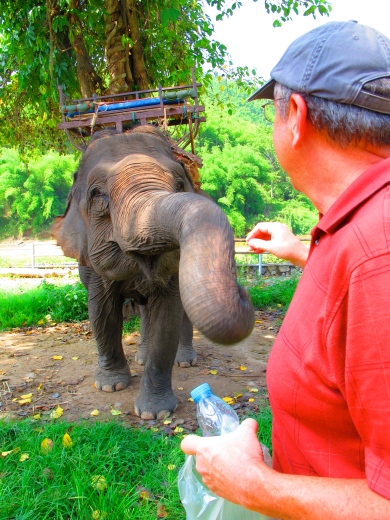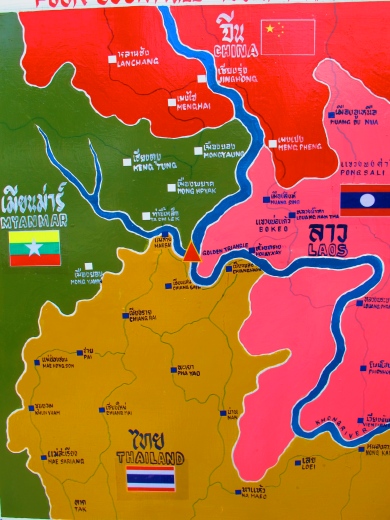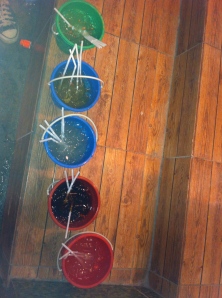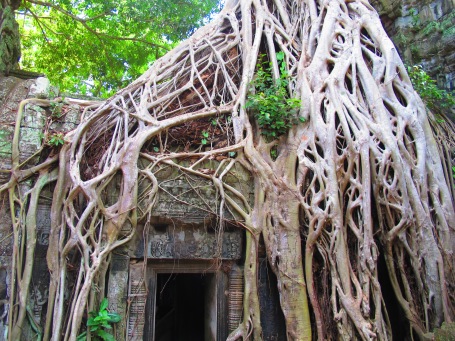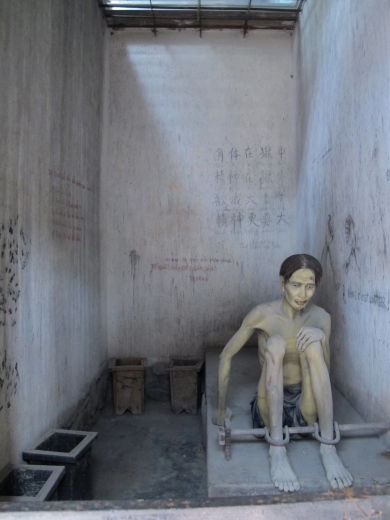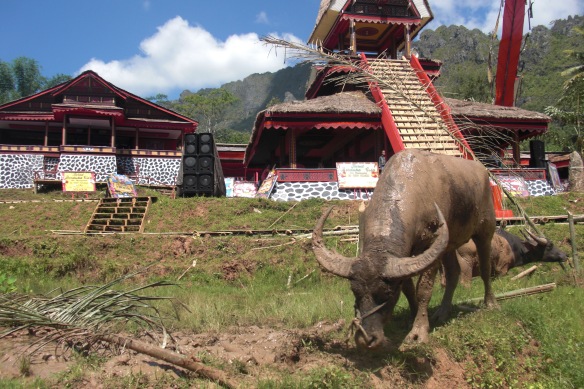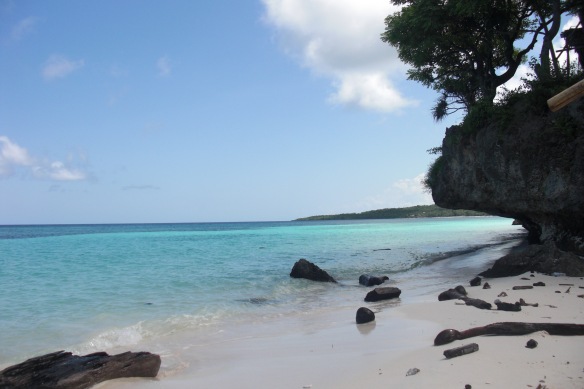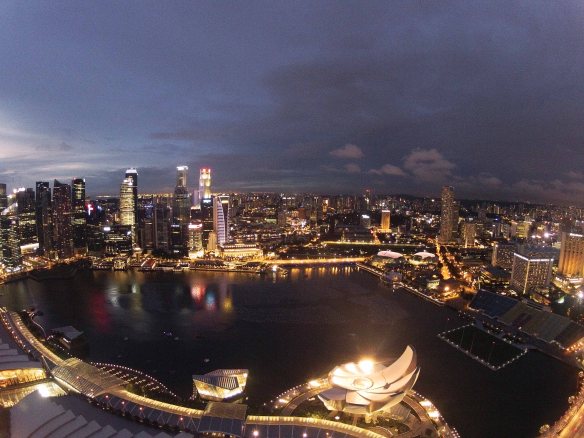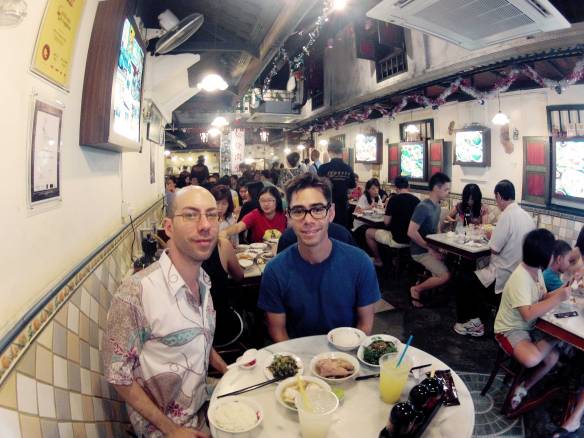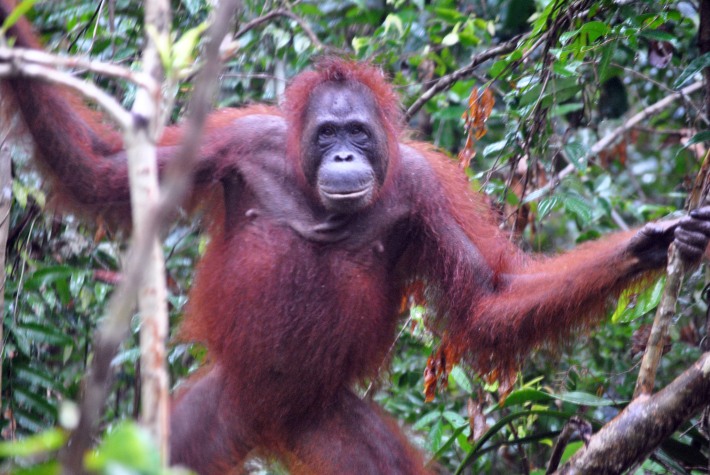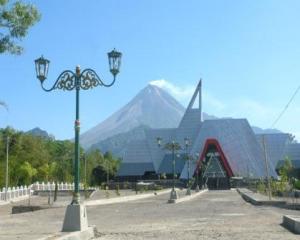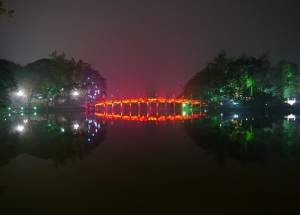Hi All,
This is my (Katie, ID6) post on my recent trip through SE Asia. It’s pretty logistical in case you’re wondering about costs, lodging etc. I hope you enjoy!
THAILAND
I traveled to Thailand in two doses. First, I spent a week there with my parents visiting from the U.S., and then, after a jaunt in Singapore, another week with fellow ID6 PCVs Melanie and Rachel.
Bangkok
Going
To fly from Surabaya to Bangkok, Tiger Air has a layover in Singapore but Air Asia has a direct flight once a day.
Cost of Flight:
One-way: $123 (my parents flew one-way)
Round-Trip: $231 (I had a round-trip ticket booked)
Time:
Surabaya to Singapore: 2hr 25min
Singapore to Bangkok: 2hr 30min
Direct, Surabaya to Bangkok: almost 4 hr
Arriving
Taxi
We arrived in Bangkok in the late afternoon, the perfect time to get stuck in a traffic jam. There are two airports in Bangkok: the older Don Mueang (DMK) and the newer Suvarnabhumi (BKK). I did not ever fly into BKK but it has an easy connection to Bangkok’s ‘sky train’ that can get you into the city much quicker than driving during high traffic times. Because all the Thai our trio could squeak out collectively was a pathetic ‘hello’ and ‘thank you’, we unknowingly opted for a taxi during rush hour in this 8-million-plus populated city. The trip from DMK to center city Bangkok (near the Grand Palace) took us a whopping 3 hours and cost 300 baht in a metered taxi. Note: all taxis from the airport require a 50 baht surcharge in addition to what’s run on the meter.
Later, I did this same taxi trip with Melanie and Rachel. We arrived around midnight at DMK, took a taxi and experienced no traffic at all. The trip took well under an hour from DMK to center city and cost around 200 baht including the 50 baht surcharge.
Train
If flying into DMK before 9pm, I recommend that you forego naiking any taxi and take the local train from DMK to Hualamphung train station. Hualamphung is in center city Bangkok, near China Town. Even if you aren’t staying in China Town, the local train is much quicker and cheaper than taxis or buses that have to drive through Bangkok traffic. While it’s no TGV, the train clunks along at a steady pace, whizzing passed the bumper-to-bumper traffic. There’s no AC but tickets cost a mere 5 baht. The transit from DMK to Hualomphung takes less than an hour.
Accommodation
Because I did Bangkok both as the daughter of parents with real salaries and as a PCV with a rupiah salary, I saw the best of both worlds in Bangkok’s housing options.
Higher-end Housing
I stayed at a guesthouse on the river called Arun Residence. This place is an absolute gem. It’s tucked away in a small (yet safe and clean) ally across from Wat Pho (one of Bangkok’s most popular temples). It’s a 10 minute walk to the Grand Palace and maybe a 30 minute stroll to Kao San Road (aka the epicenter of all backpackers and their seedy activities). At Arun Residence, we had a fantastic view of Wat Arun from our balcony. The restaurant was fabulous and the rooftop bar also had a fantastic view. Arun Residence was also a five minute walk from a water taxi stop, stop 8.
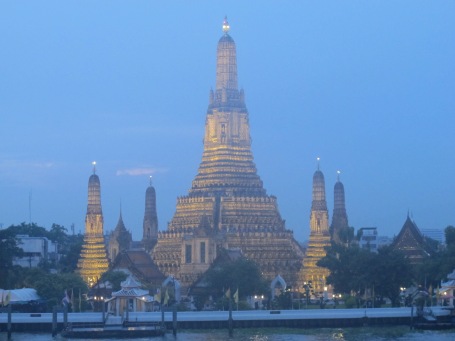
The View of Wat Arun from our balcony at Arun Residence
We also stayed one night at a hotel near the airport at theMiracle Grand. It’s literally up the road from the airport terminals at DMK and a good place to rest up if you have an early or late flight to catch. The Miracle Grand is a conference hotel with enough restaurants and shops within the actual hotel to keep you occupied if you’re only staying there for a night’s sleep.
Hostel Housing
Later with Melanie and Rachel we of course stayed in hostels. Upon fellow PCVs’ recommendations, we showed up our first night together in Bangkok at 3 Howell Hostel. Upon entering the guy at the desk asked if we had already booked spots to sleep. We answered, “no,” to which he replied, “why not?”
We were able to stay one night at 3 Howell. It was a great hostel with air conditioned, ladies only, and mixed dorms. They have plenty of showers and restrooms, a lot of bean bags and cushions to relax on, FREE, FAST WIFI, a TV room with plenty of relatively good films to watch, computers for use on the first floor, and breakfast for 80 baht per person.
After being graciously kicked out after our first night since we didn’t book ahead, the three of us checked out a hostel on a street perpendicular to that of 3 Howell. Full Hostel was one of our best finds in Bangkok because it was ridiculously inexpensive. The staff are a Korean couple who had just opened this hostel (I seriously believe we were some of their first patrons) which is clean, air conditioned and also has fast, free wifi. The rooms and beds seemed brand new and are comfortable. There was only one shower/toilet on our floor which meant it got a little tricky to coordinate when you could pee but because the price can’t be beat (200 baht a night), I have nothing but great things to say about Full Hostel.
Both of these hostels are located about a 5-10 minute walk to Kao San Road and 30 minutes to main attractions like the Grand Palace and Wat Pho. You can get laundry done in the street and there’s a fantastic restaurant/bar at the end of Full Hostels’ street that serves Belgian beers and delicious breakfasts. There are also plenty of Thai-owned spots to eat or grab an iced coffee for 20 baht near the hostels.
Cost and Location
Arun Residence: $200 per night (I think), including buffet and to-order breakfast with FREE MIMOSAS; 36-38 Soi Pratoo Nok Yoong, Maharat Road, Rattanakosin Island, Bangkok
Miracle Grand: $50 per night; 99 Vibhavadi-Rangsit Road
3 Howell Hostel: 400 baht per night per person; 316/5 Samsen Soi 4
Full Hostel: 200 baht per night per person; not yet online, located off Samsen Soi 4, catercorner to 3 Howell (not yet online, so go find it!)
Things to do in Bangkok
Temples
Temples are plentiful and neat to visit. If you are going to do only one (which in my opinion is enough) choose either the Grand Palace or Wat Pho. You can spend a few good hours exploring the grounds of both of these spots. The Grand Palace features a temple housing the surprisingly small ‘Emerald Buddha’ (which must not have been discovered by a geologist as it’s actually made of jade) . Wat Pho is home to the ‘Reclining Buddha’ who, unlike the Emerald Buddha, is enormous. There’s also Wat Arun which is fun because you can climb up the Chedi and get a nice view of the river. Check when temples are open to visitors as some do close for a couple hours for monks’ prayers.
Entrance Fees:
Grand Palace: 500 baht
Wat Pho: 100 baht
Wat Arun: 50 baht
Kao San Road
This and its parallel twin sister road, Ram Bhuttri houses nothing local but is saturated in tourist bars, shops, and hotels. These streets never sleep. There’s a ton of street food, restaurants, and things to buy in Kao San area. You’ll run into more bule here than Thais but it’s definitely worth walking around to get any souvenirs you may want and to try some tasty street pad thai, schwarma, fresh fruit, or beers to go. Bargaining is obligatory. There are also plenty of Thai massages available here. You’ll pay at least 20 baht more than at other small massage parlors outside of Kao San Road but getting a massage at 2am is a nice option to have.
Prices:
Large Beer: 70 – 100 baht
Pad Thai: 30 – 60 baht
Shwarma: 60 baht
Smoothies: 20 – 40 baht
Average plate at a restaurant: 100 baht
Street Meat: 20 (chicken) – 150 (octopus) baht
Fresh fruit: 20 (mango/papaya/pineapple) – 70 (durian) baht
Fried bugs: 20 (grasshoppers) – 150 (scorpions) baht
Clothes: 100 – 300 baht for shirts; 100 – 400 baht for pants
China Town
I walked from Arun Residence to Hualamphung train station twice which put me through China Town and its stores of…junk. It’s interesting to walk around but a lot of the stores sell things like used electronics, kitchenware, and clothing that just wasn’t my style. There are also cool markets within China Town where you can get nuts, spices, and fresh meat but because I didn’t plan on cooking up pork shanks in my hotel, all I bought in China Town was durian. There are also plenty of restaurants serving up Chinese food with a Thai twist. The one lunch I had there cost around 80 baht.
Sukhumvit
This is an area of Bangkok that houses a lot of shopping and the higher end hotels (like Sheraton, Four Seasons, and Sofitel). It’s characterized by a lot of expat bars and nightclubs, large shopping malls, restaurants of all the world’s cuisines (Rachel and I had delicious Indian food in this area), and, unfortunately, lots of street prostitutes. This area runs along the BTSsky train line so if you’re interested in taking the sky train, Sukhumvit is a good place to get off at and walk around for a while.
Boat Trips
One evening, my parents and I booked a boat trip that took us up the main Chao Phraya River and through many small canals through Bangkok’s less visited neighborhoods. The trip lasted around an hour and, if you time it right, the city looks beautiful as the sun sets and begins to light up. You can bargain for these trips at any of the main taxi stops along the river (Papa Starr paid so I’m not sure how much this cost).
Day Trips
Melanie, Rachel, and I took a day trip to visit a floating market, ‘The Bridge over the River Kwai’, and a forest monastery housing a tiger temple. We booked the trip through a tourist office, were picked up at our hostel at 7am, and arrived back in the city around 6pm. Despite being a long day, it was awesome to see the morning floating markets at Damnoen Saduak and visit the forest monastery, or ‘tiger temple, at Kanchanaburi. The floating markets were fun to walk along and sample the food being served out of the boats. We tried coconut ice cream, grilled bananas, and a weird sweet that looks like tacos but tastes more like an Indonesian kue. Between the floating market and the tiger temple, our large van made a stop at the Bridge Over the River Kwai which is simple a bridge that crosses over the Kwai River – do not make it a point to visit just this.
I was a little apprehensive when we arrived at Wat Pa Luangta Bua Yannasampanno, or the Forest Monastery Tiger Temple. First, we weren’t informed by the tour company that this was a temple since it was advertised as a ‘tiger sanctuary’. But it is indeed a templehousing monks and, like all temples, you must dress appropriately. I had on jean shorts and Rachel was sporting atank top so we had to spend almost an hour begging people to let us borrow things to cover up with. Once Rachel got ahold of our driver’s jacket and I borrowed some man’s scrub-like pants, we queued up to get spend some quality time with the dozen or so tigers in the ‘tiger canyon’ section of the forest. Visiting with the tigers was simple: you hand your camera to a staff, they take you by the hand (literally), and lead you around to meet all the tigers lounging around in the sun while they snap your picture. While standing in line, I was convinced that all the tigers were drugged. ‘How can they just be laying around like this and not care about the crowd of people buzzing around them?’ It turns out that the tigers aren’t drugged according to the bule director of Tiger Canyon and the brochurethat has a Q&A section about how the animals are treated.
Apart from hanging out with the tigers, the rest of this forest monastery is teeming with animals big and small. Most livestock creatures are roaming around (there was definitely a moment while exiting that I was nervous about being charged by a large swine of some breed of bovine) and there are some other cool animals, like THIS ENORMOUS BEAR
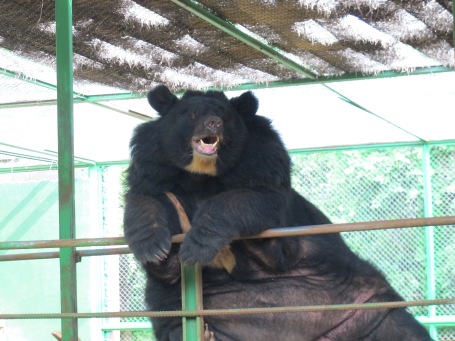
Said Bear
The cost of this trip was 750 ($25) baht per person and included lunch.
Chiang Rai
After Bangkok, I visited Chiang Rai with my parents for three nights. We flew from Bangkok to Chiang Rai via Air Asia, $82 round-trip per person. Chiang Rai was recommended to me by a friend over the other popular northern Thailand spot, Chiang Mai, because it was supposed to be less touristy and still rather low-key. And it is for the most part. In Chiang Rai’s center town area, there’s a popular night market with entertainment on stages in a town-square-like quad. Vendors are comprised of villagers from different hill tribes in the surrounding foothills selling their various hand-made crafts. Aside from exploring the town, the main thing to do out of Chiang Rai is go on day trips. We booked two day trips for our resort, The Legend: one to the nearby ‘Golden Triangle’ and one excursion to ride elephants into the hills.
The Golden Triangle used to be the main transit hub for opium trade between Thailand, Myanmar, and Laos and is now a cool place to visit to see the three countries converge along the Mekong River. From the Golden Triangle point in Thailand, we took a fisherman’s boat up the riverto set foot on Myanmar and Laos. There’s also a couple of beautiful temples along the way to be seen. Our trek into the hill-tribe villages via elephant was beautiful but two hours atop an elephant was a bit much for me. At the end of our elephant trek, we lunched in a house in the hill tribe village before hiking back down towards Chiang Rai, stopping to see the Huai Mai Saii waterfall. Because there is no electricity in many of the northern hill-tribe villages of Thailand, the village we visited was solar powered.
Accommodation
The Legend Resort – along the Kok River, this resort is comprised of beautiful bungalows and has a swimming pool, spa, restaurant, and wine bar that serves delicious imported beer, included Oregon’s own Rogue brews. Rogue Dead Guy Ale, anyone??
Koh Tao and the Full Moon Party
Koh Tao is one of three major islands on Thai Gulf coast. It’s mainly patronized as a diving hub and most tourists visit in order to explore the reefs in the Thai Gulf. Meeting up with ID5s Nicole and Allison LV, Melanie, Rachel, and I stayed on this island not because we wanted to use it as a portal to go diving but as a portal to the Full Moon Party hosted on nearby Koh Phangan. Knowing that the Full Moon Parties rage on all night and that Koh Phangan only has about three thousand rooms on the island, most of which require a minimum booking of five days, we opted to stay on Koh Tao and take the ferry over to Koh Phangan for the party.
Full Moon Parties happen monthly and are an all night rage fest with 5 – 10 thousand partygoers dancing, drinking, and drugging on Hat Rin Beach, Koh Phangan. It also requires that you paint yourself neon because, why not?
We arrived at Koh Tao around 10 am after taking the night train from Bangkok to Chumphon, naiked a bus to Surat Thani pier, and got on a two-hour express boat ride to arrive in Koh Tao around 10 am. Once we checked in to our hotel, Asia Resort, we started inquiring about ferries to Koh Phangan for the party that night. Most ferries were booked full but we lucked out with a friendly boat agency worker who got us on a 2pm boat to Koh Phangan.
The trip from Koh Tao to Koh Phangan takes 1 – 2 hours, the cost of a round-trip ticket was 1250 baht. Once we arrived at Koh Phangan there were plenty of taxis available to take partygoers to the other side of the island where it all goes down on Hat Rin Beach, about a 45-60 minute trip at 100 baht per person.
Arriving at Hat Rin was strange since we didn’t really know what we were getting ourselves into. Shops and restaurant-bars emerged. We saw droves of partiers sporting neon clothes or beach attire. Because our party of five had no accommodation booked on this island and our hotel was hours away on another island, we had every intention of staying up all night or sleeping on the beach.
After a delicious dinner at an Aussie-owned pub we purchased our neon paint and brushes, took them to the beach, and painted ourselves until we were five GLOWing, off-the-clock PCVs/RPCVs. After the neon craft hour, we bought our ‘buckets’. Full Moon Party buckets are plastic beach buckets (handle included) that come with a small bottle of liquor and two chasers of your choice. Everything is unopened so you can mix as you please and get ice from the bucket vendors. They cost under 100 baht.
By dark the beach had transformed into a fire-breathing, neon light-flashing, sandy dance floor. By midnight/1am-ish, the beach was even more unrecognizable as thousands of people partied on, making the beach’s surf their highway. The music, drinks, and characters were endless. Before we knew it, the sun had risen and we were left squinting in the daylight through our, now flaky, neon-adorned eyes. After a taxi ride back to the pieron Koh Phangan, we took the 8am ferry back to Koh Tao where we slept for a day. Literally.
Interested in trying this?
I would stay on Koh Phangan, especially if you’re only going for the Full Moon Party. The trek from Koh Tao to Hat Rin Beach included too many taxi and ferry transits, plus my bed was miles away and by 6am I would have appreciated having a pillow on which to rest my head.
If you do stay on Koh Tao, pick a hotel close to thpier. Asia Resort was a thirty minute walk uphill or a rather expensive taxi ride to the pier. Also, arrive a day early if staying on Koh Tao so that you can arrange ferries – they fill up fast!
Be vigilant. I hate to pull a Shindu but keep leave your possessions behind for the actual party. I had only whatever I could fit in my pockets and that was enough.
Don’t get ‘bucketed-out’ too early. We saw someone getting carried off the beach around 8 or 9pm and later saw friends carrying their ragingly drunk buddies to bathrooms – don’t be that guy.
Drugs are everywhere and police are too. Use with caution.
Visit the Reggae House on the main street leading to Hat Rin Beach. Just do it.
Accommodation
Asia Resort is located on Koh Tao, about a 30-minute walk from the pier. Sairee Beach is right around the corner, which has cool bars with feet-in-the-sand seating. The staff were lukewarm with us and weren’t very helpful in helping us figure out how to get to Koh Phangan because all the ferries were seemingly full. The rooms were nice enough, there’s a beautiful pool, and the breakfast we had there was good.
Cost and Location: $12 per night for a double; 18/1 Sairee Beach Koh Tao
Leaving
To get back up to Bangkok, there are trains from Chumphon or direct buses from Surat Thani pier. They both take 7 – 8 hours. The cost of one ferry and bus ticket from Koh Taoto Bangkok was 950 baht.
SINGAPORE
I love this city. It’s diversity and history are quite the anomaly but it also felt like a dose of home. Walking through the streets of Singapore felt like walking through the streets of any large city in the U.S. The public transportation is flawless and the food options are endless.
Accommodation
I stayed here three nights with my parents and one night on my own in an area near China Town. I liked the area because the Maxwell St. food stalls in China Town are delicious andcheap (you can eat and drink for $5) and all districts were walkable.
Best Western Jayleen 1918 is located between two main streets, New Bridge and South Bridge roads, and is within walking distance of The Central metro stop. It’s about a thirty minute walk to downtown Singapore, Little India, and the Financial District. The rooms are nice and lodging includes a breakfast buffet with FRENCH TOAST AND SYRUP.
Cost and Location: 42 Carpenter Street
Five Stones Hostel is a discreet building on the main South Bridge Road. It has a couplefloors of dorm rooms and the best water pressure I’ve experienced in Asia, ever. The rooms are air conditioned, the staff are friendly, and lodging includes breakfast. This is also located near China Town and is about a 10-minute walk from two different MRT (mass rail transit) stops: Clark Quay and Raffles Place.
Cost and Location: $25 per night; 61 South Bridge Road, Level 2
Things To Do in Singapore
The Night Safari at the Singapore Zoo
The night safari is one of the coolest zoo experiences I’ve had. The habitats are arranged so that there’s no fencing obstructing views of the animals. Some habitats that you walk or drive through are completely open with animals roaming about. Going at night is cool because a lot of animals are more active at night than during the day (including theRichard Parker of Singapore). The only fencing I noticed was the ticking of an electric fence around the hyenas’ habitat and thank goodness for that. You can either walk through the zoo on different, marked paths or naik a tram that takes you through the entire zoo with a guide dropping facts and corny jokes about the animals housed in the zoo. I recommend doing the tram ride first (at 30 – 40 minute ride) and then walking back to places you want to see again.
Clark Quay
Clark Quay is a boardwalk along the Singapore River that has a lot of cool shops and riverside restaurants. This is a great place to take advantage of happy hour.
The National Library
Located in downtown Singapore, the National Library is a gargantuan building with a great library and also a neat theater on the second floor. They have comedies, dramas, and other theater productions that play there.
China Town
China Town is worth walking through at least once. It’s filled with souvenir stalls and tailors ushering you into their shops for a fitting. At the Maxwell Street food stalls are a great selection of cheap Asian cuisine.
Transportation
I bought an MRT card, called an ez-link, and first loaded it with 10 SD. You can use the card on all forms of public transport including the bus lines and the MRT. You swipe thecard once upon entering a subway or a bus and once upon exiting. The amount deducted depends on how far you traveled and your balance is shown on the scanning machine. Refilling the card can be done at any MRT stop.The transportation here is enviable!
CAMBODIA
The Kingdom of Cambodia requires a visa to enter. You can get them upon arrival but they are also available online as e-visas for $30 per visa. Rachel, Melanie, and I each had our e-visas purchased before crossing the border, but that doesn’t mean we didn’t get the run-around at the border from pushy scammers. The US dollar is used and accepted everywhere. I would suggest getting some Cambodian Riel as well as it’s cheaper to use Riel in some instances (like when buying water).
Arriving
We took a train from Bangkok’s Hualomphung to Aranyathamphu, the Thai/Cambodian border station. The train leaves early (5:55 am) every day and costs 48 baht. It takes about seven hours. After arriving at Aranyathamphu, there are plenty of tuk-tuk drivers available to take you to the Poipet border crossing. It should cost no more than 100 baht total. Ourtuk-tuk driver was a royal douche who took us to an office where we booked a cab from the border to Siem Reap (our final destination). You don’t have to do this. From the Poipet border crossing, after you get your Thai exit stamp and your Cambodian entry stamp, there is a FREE shuttle bus to a taxi terminal where you can take a share taxi to Siem Reap for $12 per person. We paid 600 baht per person for door-to-door service but not without their pushing Angkor Wat tuk-tuk guides on us. Our fatigue from Full Moon Partying and the Cambodian heat and dust resulted in Melanie and Rachel (in the most Peace Corps way possible) telling the driver to leave us alone and let us out immediately. After walking through the town of Siem Reap until we found our home stay, it was already around 6pm.
Siem Reap
Accommodation
We stayed at a beautiful, cheap guesthouse called The Prohm Roth Inn, located on a main strip and about a 15 minute walk to the popular ‘Pub Street’ and old market. The staff were extremely nice Cambodians who helped us book a tuk-tuk around Angkor Wat for a day at $15 total, including water. The rooms have AC and the Wifi is free and fast. There’s also breakfast included which is cooked to order.
Cost and Location:
The Prohm Roth Inn: $21 per night for a 3-person room, AC, wifi and a comfy balcony;includes breakfast; Wat Bo Road
Things To Do in Siem Reap
Angkor Wat
The first and practically only reason tourists come to Siem Reap is to visit the temples at Angkor Wat. They are many and fascinating. Tuk-tuk tours for the day should cost $15 total, including water. Entrance into Angkor Wat for one day is $20 per person. My favorite stops in this city of temples was Angkor Wat, Baphuon, and Ta Phrom.
The Old Market
Similar to Indonesian Pasars, the Old Market in Siem Reap sells mostly food and has a few spots to sit and eat cheaply. It also has some tourist shops selling clothes and perfumes.
Pub Street
A place that reminded us of New Orleans’ Bourbon Street, Pub Street is exactly what it sounds like. Luckily, beer is cheap and plentiful in Cambodia so this street boasts a lot of happy hours where you can drink for 50 cents a beer (I recommend Beer Lao). At night, some of the places get a bit clubby which is fun for as long as you’re willing to hang with the backpacking crowd.
Psar Chas
This is a market area with small Parisian-style streets with boutiques, restaurants, andbars. We enjoyed shopping here.
Leaving
To depart from Siem Reap, we bought bus tickets through a tourist office. Tickets from Siem Reap to Kampot should cost $11-14 each.
Kampot
Arriving
We took a bus from Siem Reap to Kampot, passing through Phnom Penh to change buses. Similar to Indonesia (and maybe more extreme), the buses are slow as they stop often. The roads in southern Cambodia also proved to be much less paved than anything I’ve ever experienced in Indonesia. The total trip took us almost 15 hours. Once we arrived, however, it was completely worth it.
Accommodation
Bodhi Villa was recommended to me by a friend who had stayed there and vowed to pass along this gem of a guesthouse to others. After staying there, I vowed to do the same. Bodhi Villa is an Aussie-owned, Cambodian-run bungalow paradise on the Teuk Chhou River. The Hotel California of Southeast Asia, there’s a reason why ‘You can check out anytime you like but you can never leave’ is etched over a doorframe in the main bar area. They helped us get visas to Vietnam ($70 per visa processed the same day). We planned to stay for two nights and ended up extending for a third night. We could have extended for the rest of our trip. The bar serves delicious drinks and food all day and for great prices. The best burger I may have ever consumed in my life costs $4 and most drinks cost under $2. I cannot stress how wonderful of a place this was to stay. If you’re looking to get off thebeaten path in Cambodia and relax while meeting great people, come here!
Cost and Location:
$8 per night per Bungalow (a bungalow easily housed three people); located on the river off Teuk Chhou road. They also have live music parties every Friday night.
Besides relaxing in the most chill and backpacker-friendly abode ever (Bodhi Villa), the town of Kampot has a few cool spots including Ecran, a mini-theater screening good film classics (we caught a screening of The Killing Fields) where you perch upon bamboo flats adorned with pillows and cushions. For us, this theater experience topped any trip to Caputra’s Grand XI theater in Surabaya. No joke.
People also like to take day trips to Kep, a neighboring beach town. We did not do this because Bodhi Villa was so amazing that we didn’t want to leave. Ever.
In addition to trekking around town, there are also kayaks for rent at Bodhi Villa ($4 a day). I took one up the river one afternoon and found a hut owned by a Belg-Cambodian couple that served Belgian beers and yummy Cambodian food. It was unreal how quiet and peaceful the river was. There’s also a great view of Bokor mountain/hill along the river.
Leaving
Leaving was really hard to do, but we eventually took a bus from Kampot to the Vietnam border crossing at Ha Tien. Bus tickets from Kampot to Ho Chi Minh City cost $17 per person.
VIETNAM
Arriving
U.S. citizens must secure a visa before entering Vietnam. We got ours through Bodhi Villa in Kampot ($70 per visa for same-day processing) but you can get them at any Vietnamese Embassy on your own. We hired a van to drive us from Kampot to the Ha Tien border crossing. From there, we took a sleeper bus to Ho Chi Minh city. The entire trip took around 12 hours but riding in the Vietnamese sleeper buses, it was almost enjoyable. The cost from Kampot to Ho Chi Minh City was $17 per traveler.
Ho Chi Minh City
Arriving
Our bus dropped us off at the main bus terminal around 7pm. We then took a metered taxi to District One (around 80,000 dong).
Accommodation
We stayed in a room for rent called Than. The room was air-conditioned and Wifi was free. Located on Bui Vien Street, a backpacker-friendly section of District One, we had access to street food and restaurants with Vietnamese and Western cuisine. The owner was friendly and very helpful.
Cost and Location: $20 per night; 84/9 Bui Vien St. Pham Ngu Lao Ward, District 1 HCMC
Things To Do in Ho Chi Minh City
We didn’t venture outside of District 1 during our four-day jaunt in HCMC but found plenty to see and do while there.
The War Remnants Museum
Heartbreaking and difficult (emotionally) to get through, the pieces of Vietnam’s tumultuous history on display at this four-story museum make visiting it unforgettable. Each floor and room has a sort of theme, beginning with galleries depicting various countries’ protest campaigns against America’s ‘occupation’ or ‘invasion’ of Vietnam. One of the most unforgettable floors for me was one housing a gallery of stories depicting the crippling effects of Agent Orange, a defoliant spray used heavily by the U.S. during warfare that is still wreaking havoc on Vietnam’s population. I could go on about how interesting I found this museum to be, but it’s definitely a must see while in Ho Chi Minh City.
Entrance tickets are 15,000 dong per person
The Fine Arts Museum
Housed in a gorgeous colonial-style former residence donated to the city by its French proprietor, the art museum houses contemporary art and ancient sculptures. The building alone is worth checking out.
Tickets cost 10,000 dong per person.
De Tham Area
This area is in the southwest corner of District 1 and is home to most backpackers traveling through HCMC. There are a lot of tourist shops, restaurants, and street food in this area. While it may sound a lot like Bangkok’s Kao San Road, it’s still much more ‘local’ than the backpacking areas of other cities we visited. There’s also a delicious juice stand here on Bui Vien Road – 5 Boy had smoothie enthusiasts from all around the city stopping in to get their juice. At 20,000 dong per smoothie, it’s completely worth the wait! Also on Bui Vien road is a restaurant/film house. If you order at least one drink or food item, you can sit in Bobby Brewer’s movie theater all afternoon. We caught a showing of Old School before flying out of the city. Will Ferrell was even more fun to watch over a bowl of Pho.
Cho Benh Thanh Market
This local market is housed in a high-ceilinged barn-like structure. We visited here towards the evening and most stalls were already beginning to close up shop. It has everything from Vietnamese food to clothes and shoes.
Leaving
After eating our way through HCMC, we took a metered cab from Bui Vien road to the Saigon Airport. The trip took around 30 minutes and cost 160,000 dong. An Air Asia flight from HCMC to Bangkok cost $88 per person and took about two hours.
THE END
Thus ends the logistical summary of my trek through SE Asia. As the say in Thailand, it was ‘Same Same but different’ from Indonesia. Please let me know if you have any questions or corrections about anything posted above.

